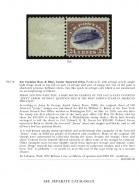⇚ Position 21 - 2008-06-07 Transaction Summary
Purchase Date:
2008-06-07
How Purchased:
Auction
Where Purchased:
Siegel Auction Galleries
Auction No.:
958-2008 Rarities of the World
Lot No.:
706
Sound/Fault:
Sound
Catalogue Value:
$ 400,000
Realized:
$ 400,000
Seller:
Anonymous
Buyer:
Anonymous
Description
24c Carmine Rose & Blue, Center Inverted (C3a). Position 21 with selvage at left, single light hinge mark at top left on part of selvage and part of stamp, the rest of the gum is absolutely pristine, brilliant colors, tiny thin speck in selvage only which is not mentioned on accompanying certificate
FRESH AND FINE-VERY FINE. A RARE SOUND EXAMPLE OF THE 1918 24-CENT INVERTED "JENNY" ERROR. WITHOUT QUESTION THIS IS THE MOST FAMOUS STAMP IN AMERICAN PHILATELY.
According to Jenny by George Amick (Amos Press, 1986), the original sheet of 100 Inverted "Jenny" stamps was purchased for $24 by William T. Robey at the New York Avenue Branch Post Office window in Washington D.C., on May 14, 1918, one day after the stamp was first placed on sale at the main post office. On May 20, Robey sold his sheet for $15,000 to Eugene Klein, a Philadelphia stamp dealer. Klein had already arranged to sell the sheet to Col. Edward H. R. Green for $20,000. Colonel Green instructed Klein to divide the Inverted "Jenny" sheet into singles and blocks, and to sell all but a few key position blocks.
It is well-known among stamp specialists and professionals that examples of the Inverted "Jenny" come in different grades of freshness and condition. Many of the original 100 stamps were mistreated by collectors during the years, despite the stamps' rarity and value. Colonel Green himself allowed moisture to affect some of the stamps he retained. Other examples have become slightly toned from improper storage and climatic conditions. Hinge removal has caused thins and creases in numerous stamps, and a few have been "lost" to philately -- or nearly so, as in the case of the copy swept up in a vacuum cleaner.
The stamp offered here, Position 21 with the left sheet selvage, is exceptionally fresh and very lightly hinged. The attached selvage immediately identifies it as a stamp from the far left vertical row.
Ex Lehman. With 1977 Robson Lowe certificate of opinion and 2008 P.F. certificate.
The stamp was offered in its own catalogue
FRESH AND FINE-VERY FINE. A RARE SOUND EXAMPLE OF THE 1918 24-CENT INVERTED "JENNY" ERROR. WITHOUT QUESTION THIS IS THE MOST FAMOUS STAMP IN AMERICAN PHILATELY.
According to Jenny by George Amick (Amos Press, 1986), the original sheet of 100 Inverted "Jenny" stamps was purchased for $24 by William T. Robey at the New York Avenue Branch Post Office window in Washington D.C., on May 14, 1918, one day after the stamp was first placed on sale at the main post office. On May 20, Robey sold his sheet for $15,000 to Eugene Klein, a Philadelphia stamp dealer. Klein had already arranged to sell the sheet to Col. Edward H. R. Green for $20,000. Colonel Green instructed Klein to divide the Inverted "Jenny" sheet into singles and blocks, and to sell all but a few key position blocks.
It is well-known among stamp specialists and professionals that examples of the Inverted "Jenny" come in different grades of freshness and condition. Many of the original 100 stamps were mistreated by collectors during the years, despite the stamps' rarity and value. Colonel Green himself allowed moisture to affect some of the stamps he retained. Other examples have become slightly toned from improper storage and climatic conditions. Hinge removal has caused thins and creases in numerous stamps, and a few have been "lost" to philately -- or nearly so, as in the case of the copy swept up in a vacuum cleaner.
The stamp offered here, Position 21 with the left sheet selvage, is exceptionally fresh and very lightly hinged. The attached selvage immediately identifies it as a stamp from the far left vertical row.
Ex Lehman. With 1977 Robson Lowe certificate of opinion and 2008 P.F. certificate.
The stamp was offered in its own catalogue

